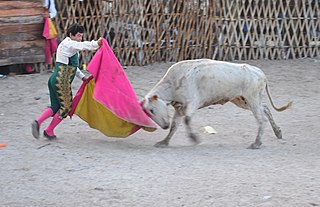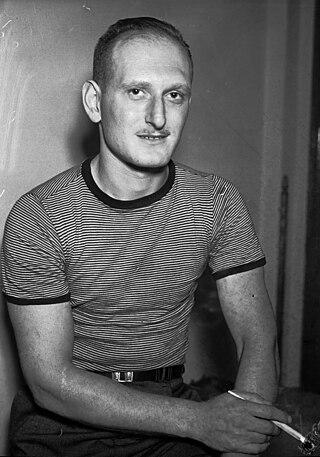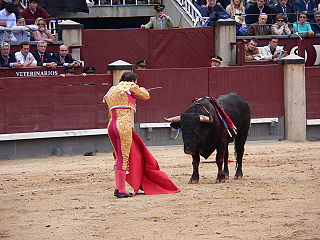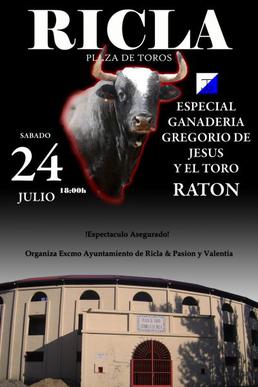
Enrique Robles of Madrid, Spain, also known as Chicorrito was a champion torero in Mexico and in Spain. [1] By 1927 he had killed over 1,000 bulls and had 70 scars from being gored. [2]

Enrique Robles of Madrid, Spain, also known as Chicorrito was a champion torero in Mexico and in Spain. [1] By 1927 he had killed over 1,000 bulls and had 70 scars from being gored. [2]
He toured the United States between 1902 and 1929 giving bullfights. [3] In 1929 he had to cancel his exhibition when the police refused to let him hold a demonstration in Times Square. [4] He may be buried in Valencia, Spain. [5]

A bullfighter is a performer in the activity of bullfighting. Torero or toureiro, both from Latin taurarius, are the Spanish and Portuguese words for bullfighter, and describe all the performers in the activity of bullfighting as practised in Spain, Portugal, Mexico, Peru, France, Colombia, Ecuador, Venezuela and other countries influenced by Portuguese and Spanish culture. The main performer and leader of the entourage in a bullfight, and who finally kills the bull, is addressed as maestro (master), or with the formal title matador de toros. The other bullfighters in the entourage are called subalternos and their suits are embroidered in silver as opposed to the matador's gold. They include the picadores, rejoneadores, and banderilleros.

Manuel Benítez Pérez, more commonly known as El Cordobés, is a Spanish bullfighter, matador, and actor active in the 1960s who brought an unorthodox acrobatic and theatrical style to the bullring.

Juan Belmonte García was a Spanish bullfighter. He fought in a record number of bull fights and was responsible for changing the art of bullfighting. He had minor deformities in his legs which forced him to design new techniques and styles of bullfighting.

Manuel Laureano Rodríguez Sánchez, known as Manolete, was a Spanish bullfighter.

Vicente Blasco Ibáñez was a journalist, politician, and a bestselling Spanish novelist in various genres whose most widespread and lasting fame in the English-speaking world is from Hollywood films that were adapted from his works.

Enrique García Asensio is a Spanish orchestral conductor. In 1970, He was made as Professor of Orchestral Conducting at the Madrid Royal Conservatory. Asensio was also the conductor of the Spanish Radio and Television Symphony Orchestra (RTVE) from 1966 to 1984 and from 1998 to 2001.

The Spanish Fighting Bull is an Iberian heterogeneous cattle population. It is exclusively bred free-range on extensive estates in Spain, Portugal, France and Latin American countries where bull fighting is organized. Fighting bulls are selected primarily for a certain combination of aggression, energy, strength and stamina. In order to preserve their natural traits, during breeding the bulls rarely encounter humans, and if so, never encounter them on foot.

Sidney Franklin was the first American to become a successful matador, the most senior level of bullfighter.

El Fandi is statistically one of the most skilled matadors in the world. Currently, he is ranked number one among all bullfighters in Spain.

Alfonso Enrique Ponce Martínez, also known as Enrique Ponce, is a Spanish bullfighter.
Jaime Bravo was a Mexican matador during the 1950s and 1960s. Bravo was known for his death-defying style and numerous relationships with various women and Hollywood starlets.

Spanish-style bullfighting is a type of bullfighting that is practiced in several Spanish-speaking countries: Spain, Mexico, Ecuador, Venezuela, Peru, as well as in parts of southern France and Portugal. In Colombia it has been outlawed but is being phased out with a full ban coming in effect in 2027. This style of bullfighting involves a physical contest with humans attempting to publicly subdue, immobilize, or kill a bull. The most common bull used is the Spanish Fighting Bull, a type of cattle native to the Iberian Peninsula. This style of bullfighting is seen to be both a sport and performance art. The red colour of the cape is a matter of tradition – bulls are color blind. They attack moving objects; the brightly-colored cape is used to mask blood stains.

Antonio Cayetano Rivera Ordóñez is a Spanish torero or bullfighter.

Bullfighting is a physical contest that involves a bullfighter attempting to subdue, immobilize, or kill a bull, usually according to a set of rules, guidelines, or cultural expectations.

Ratón was a Spanish fighting bull that was nicknamed el toro asesino, el sangriento toro Raton and el terrible Ratón for killing three people in bullfighting rings in Spain during 2006–2011 and injuring thirty more. The bull became legendary in Spain due to the large number of gorings for which he was responsible. Bullfighting fans regarded him as a star and traveled from across the country to see the morlaco at his home at Sueca near Valencia. Matador Jesús Esteve said of Ratón: "He is a killer. He is lazy, he doesn't want to participate. He does his own thing, waiting for somebody to make a mistake. And then when he gets you, he wallops you, and he doesn't let up."

Fiesta is a 1947 American Technicolor musical drama film directed by Richard Thorpe and starring Esther Williams, Ricardo Montalbán, Mary Astor and Cyd Charisse. It was released by Metro-Goldwyn-Mayer. The screenplay was written by George Bruce and Lester Cole.
Jairo Miguel is a bullfighter child prodigy.

Julio Aparicio Díaz, also known as Julito Aparicio, is a Spanish bullfighter from Seville. Aparicio made his public début in bullfighting at the age of fourteen in 1984. He was confirmed as a torero, or matador, in 1994.

Juan José Padilla is a Spanish torero ('bullfighter'). He became a matador de toros, 'killer of (full-grown) bulls', in the town of his birth, Jerez de la Frontera, on June 18, 1994 when he was 21 years old. He was known as the 'Cyclone of Jerez' and featured heavily, both personally and professionally, in Into The Arena: The World Of The Spanish Bullfight, a shortlisted nominee for the William Hill Sports Book of the Year in 2011.

Enrique Gil Robles (1849–1908) was a Spanish law scholar and a Carlist theorist. In popular public discourse he is known mostly as father of José María Gil-Robles y Quiñones. In scholarly debate he is recognized principally as one of key ideologues of Traditionalism; some authors view him also as major representative of a theory of law known as iusnaturalismo.
Sing a song of mantillas and grated windows and flirtatious eyes and six bulls to die, for Robles, the matador, has come to town, and the Spanish part of the populace is on tiptoe for a chance to see the champion of the arenas of Madrid and Mexico slay Andalusian bulls one after another while it looks on. Enrique Robles, scion of a Castilian family, as he explained yesterday at the ..., was not destined for the bull ring by his parents. ...
Senor Enrique Robles here from Madrid known throughout Spain as Chicorrito and as having killed 1,000 bulls ... body is scarred with seventy wounds ...
... held here Enrique Robles a Spanish matador who has been giving exhibitions all over the State narrowly escaped being gored and killed by an enraged bull ...
In the picturesque mufti-colored garb of a toreador, Enrique Robles of Madrid appeared yesterday afternoon in Times Square, according to announcement, ...
He encontrado una página que hablaba de la tragedia que ocurrió ese 22 de septiembre de 1.957, y que les cita a Vds. como fuente. ...Hoy yace en Valencia, junto a un señor cuyo epitafio reza: "Chicorrito, el más grande aficionao del toreo. Gracias Maestro".